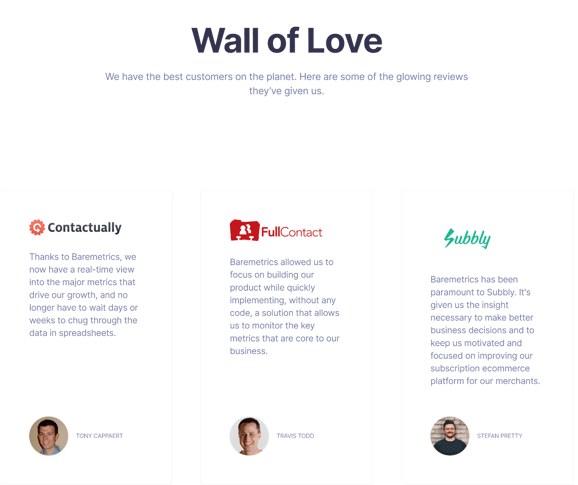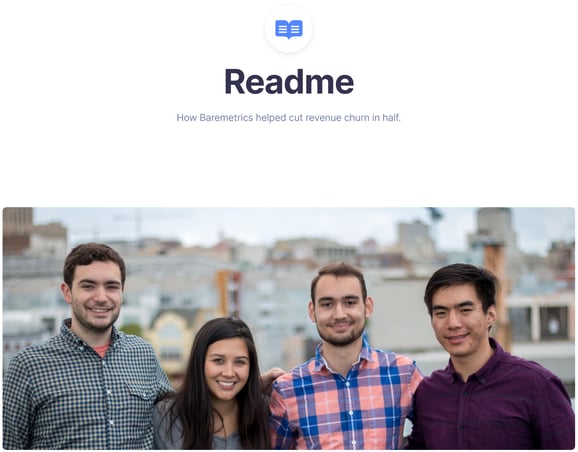Table of Contents
More Founders Journey Articles

I don’t know about you, but whenever I’m considering making a significant purchase, the first thing I do is head to the review section.
Whether it’s novelty curtains or writing software, I always want to know what my peers think about a product first. Their opinions are the ones I place the most weight in – their reviews are unbiased (compared to the product’s creators or their competitors, at least), up-to-date, relevant to my needs as a consumer, and more often than not, make for an entertaining read.
This is actually a very common phenomenon: we trust people we can relate to. That’s why politicians and business leaders often perform ridiculous stunts to appear relatable to the public, because relatability is currency.
This idea also applies to SaaS businesses. The best way for a SaaS business to attract new customers is to demonstrate how current users are successfully using their products.
It’s also worth mentioning that using satisfied customers as an advertising channel is an extremely cost-effective marketing strategy.
Keep reading to learn how to use testimonials and case studies as a powerful marketing tool for your SaaS business.
All the data your startup needs
Get deep insights into your company’s MRR, churn and other vital metrics for your SaaS business.
Testimonials vs. Case Studies: What’s the Difference?
Testimonials and case studies are both word-of-mouth marketing strategies that use the customer experience as the foundation of their campaigns.
However, there are some key differences between them in terms of structure and target audience. It’s important to know which one to use in what circumstance to maximize their effectiveness.
Testimonials
Testimonials tend to be most effective when they’re short, sweet, and come in large quantities.
Here at Baremetrics, we’ve created a testimonial collage known as our ‘Wall of Love’. Here’s the first page:

Shucks, guys.
So, what makes a testimonial page convincing? Essentially, this boils down to four elements: relevance, variety, tone, and design.
1. Relevance
What do your prospects care about the most? Think about your most popular features and make sure these appear front and center on your testimonial page.
Who you quote is just as important; your featured users should feel like peers to your prospects, and encourage the line of thinking of ‘it worked for them so it will work for me’.
If your ICP (Ideal Customer Profile) is a micro-SaaS, for example, most testimonials should be penned by fellow micro-SaaS founders.
2. Variety
Each testimonial should focus on a different aspect of your product. Think of your testimonials as a fishing net: every square uses a different bait with which to hook your prospects.
Try to mix it up so that every line contains something specific to your business, as well as some popularly searched keywords for your target ICPs.
Going back to our Wall of Love as an example, here are some of our featured buzzwords that we know are important to our prospects:
-
Growth
-
Metrics
-
Data
-
Insights
-
Churn
And here are some phrases our current users have been kind enough to say about us:
-
Definitely worth the investment
-
Makes my daily job a lot easier
-
Incredible insights
-
Our go-to dashboard
-
Friendly support and continuous product improvement
As you scroll, a lot of these terms begin to repeat themselves at regular intervals. The content of these testimonials must be 100% verbatim, but you can, and should, curate the order in which they appear in the same way you’d optimize your ad copy for maximum impact.
Ideally, the testimonial page should consolidate the core promises of your solution without seeming repetitive.
3. Tone
The most effective testimonials sound natural and fair. You want your featured users to sound enthusiastic without being over-the-top. If they’re waxing a little too lyrical, you run the risk of having prospects suspect you’ve enhanced or even purchased positive reviews.
4. Design
Good design relies on a few core principles. In order for your material to be most effective, it’s worth investing some time into learning how to best organize your page.
Here is a great guide on visual hierarchy. This principle considers what order people absorb information in, and is applied to almost all visual design.
You must also take different formats into account; your prospects might be accessing your content on a mobile, PC, tablet, etc.
How do you gather great testimonials?
The best way to collect testimonials is just to ask! If users are satisfied with your services, chances are they’ll be happy to talk about them.
You can do this via phone call or email. If it’s the former, it’s customary to send users a copy of the typed up testimonial before uploading it. You’ll also want their written consent for using their name, title, company name and photo (if you’re adding that personal touch) on your website.
Here are some prompts you might want to send your users to incorporate into their testimonials:
-
What are their favorite features?
-
What was their business life like before using your product vs. after?
-
How is your product helping them grow?
If using email is too onerous, here are some great tools for automating the testimonial gathering process.
Once users have submitted testimonials, you might ask them if they would be willing to post them on independent review sites as well. Here’s an example of Baremetrics’ review page on TrustRadius.
The benefit of posting on external sites is that a broader audience will see the review. The main group of people who will view testimonials on your own domain are prospects already considering your solution, whereas on a site like TrustRadius, users can browse through a broad range of similar products matching their search criteria.
Because the hosted review is on an external site, this type of testimonial may also strike prospects as more trustworthy.
Keeping an eye on how your company rates on various review websites will also help you monitor any customer dissatisfaction, and provide invaluable insights into how your competitors are doing relative to your product.
Case Studies
The main differentiator between case studies and testimonials is the depth of the review. Unlike a testimonial page that benefits from high volume, case studies are most effective in small quantities.
A compelling case study is solution-driven, relatable, and illustrative.
Here’s an example of the ReadMe case study for Baremetrics.

Solution-driven
What problem does your product solve, and how? This is the key question your prospects are interested in.
In our ReadMe case study, the focal point is cutting churn. This goal heads up the entire review – kind of like our tl;dr version for prospects who don’t have time to read the full article, but still want to get an idea of how our solution works in the real world.
This study is structured as Problem – Solution – Outcome. First, we outline what issue the team had been facing. Then, we describe our diagnostic process and proposed solution. Finally, we list the results of our implemented solution and demonstrate how our product helps ReadMe achieve their goal of cutting churn and increasing MRR.
By the way, if you’re also looking for a solution that can help you reduce churn, boost MRR and increase user LTV, Baremetrics analyzes your business data across 26 different metrics. These tailored financial insights show you exactly where your missed business opportunities are, what plans are bringing in more revenue than others, and where your team’s focus should be. If you’re interested in trying Baremetrics for yourself, sign up for our free trial here!
Relatable
In a case study, the voice of the user is as present as the product itself. Your prospects should be able to relate to the reviewer, which is why it’s critical that your featured users closely match your ICPs. If your product targets more than one ICP, each case study should represent a different one in order to cast a wider net.
Presumably, your ad copy already speaks volumes about the benefits of using your software. In contrast, the purpose of a case study is to showcase how exactly your solution transformed one specific business.
Prospects reading your case studies should be able to empathize with the subject of the case study. ‘Wow, we’re facing that same problem right now! This solution can work for us too’ is the ideal reaction a case study aims for.
Illustrative
Another reason prospects look at case studies is to get an inside view of the product in use.
Demo accounts and tutorial videos are great from an informational point of view, but viewing all features at once, especially for an unfamiliar type of product, can be overwhelming. (We still think ours is pretty great though!)
Instead, reading about a single feature and its real-world application in a case study can give prospects a much more concrete sense of the entire product. It’s also a faster way to form an impression with less of a learning curve than doing a deep-dive into a demo.
Include plenty of screenshots! Case studies are a great opportunity to showcase your solution in action.
Optimizing Your Testimonials and Case Studies for Marketing
The most compelling way to attract new customers is to demonstrate that your current users are satisfied with the solution that your product provides.
Featuring testimonials on your landing page is the most effective way to do that.
Essentially, this serves to convince prospects that your solution is the best on the market. Aim to feature a large volume of short testimonials to demonstrate that many, many users have chosen your product over the competition.
Case studies, on the other hand, cater to prospects who want to understand exactly how the process works. Demonstrate in detail how you solved a specific pain point for a user and transformed their business life for the better.
You can choose to focus on either type of review, or you can use both! Start talking to your users today about how you impacted their lives: a marketing goldmine is right at your fingertips.



